Levels of Priority: Key to Peak Productivity in Business and Project Management
The ability to effectively prioritize tasks and projects is a critical skill for a project manager. This is where levels of priority help to streamline workflow and boost efficiency. But what is it?
Priority levels are a system used to categorize tasks or issues based on their importance and urgency. Typically, they range from P0 (highest priority) to P4 (lowest priority), with P0 representing critical issues that require immediate attention, and P4 representing tasks that can be addressed when time allows.
The integration of prioritization methods with Six Sigma principles, often mastered through a six sigma certification, empowers project managers to streamline processes and achieve measurable results.
Throughout this article, we’ll cover:
- The fundamental concept of priority levels and their importance in business
- Various prioritization methods, including the Eisenhower Matrix and MoSCoW method
- How to create and implement a prioritization matrix in your work
- Software tools that can help manage levels of priority effectively
- Real-world case studies demonstrating successful prioritization techniques
- The integration of prioritization methods with Six Sigma principles
Understanding Levels of Priority
In my years as a Six Sigma Master Black Belt, earned through rigorous six sigma certification and training, I’ve watched so many projects either succeed or crash and burn.
The difference? It often comes down to how well teams grasp and use priorities.
Let me tell you, at its heart, prioritizing is all about making smart calls on what needs to be done now and what can sit on the back burner for a bit. It’s not just a nice-to-have skill – it’s the secret sauce that sets apart the teams that knock it out of the park from those who are always scrambling to catch up.
I’ve seen it time and time again: teams that nail their priorities tend to hit their deadlines and deliver solid results. Those that don’t? Well, they often end up in a constant state of catch-up, always feeling behind the eight ball.
It’s not rocket science, but it does take some practice and know-how. Trust me, once you get the hang of it, it’s like having a superpower in the project world. I’ve helped countless teams master this, and it’s amazing to see the transformation when they do.
Master prioritization techniques for peak productivity with Our Lean Six Sigma Green Belt training. Cover essential tools like Process Mapping and Cause & Effect Matrix to help you optimize your workflow.
What Are Levels of Priority?
I’ve noticed time and again: that people often mix up urgency and importance, thinking they’re the same thing. But let me tell you, they’re not. It’s a common mistake, but it can throw a wrench in the works.
In my experience, urgency is all about time – it’s the “how soon does this need to be done?” question. Importance, on the other hand, is about impact – it’s the “how much does this matter in the big picture?” question. When you get these two concepts working together, you can start prioritizing like a pro.
I’ve seen this distinction make a world of difference in how teams operate. It’s not always easy to separate the two, but once you do, it’s like putting on a pair of glasses and suddenly seeing everything.
The 5 Levels of Priority Explained
Through my work with top companies like GE, HP, etc. I’ve found that a five-level priority system often works best. Here’s a breakdown of these levels:
- P1 (Critical): These are your “drop everything” tasks. They’re both urgent and important, often involving crisis management or critical deadlines.
- P2 (High): Important tasks that are not immediately urgent. These often contribute significantly to long-term goals.
- P3 (Medium): Tasks that are urgent but less important. They require attention but don’t contribute as much to overall objectives.
- P4 (Low): Neither urgent nor highly important. These tasks should be done but can be scheduled for later.
- P5 (Lowest): Tasks with minimal impact that can be eliminated if necessary.
In real-world scenarios, these levels interact dynamically. For instance, a P2 task can quickly become P1 if left unattended for too long. That’s why regular review and adjustment of priorities is crucial.
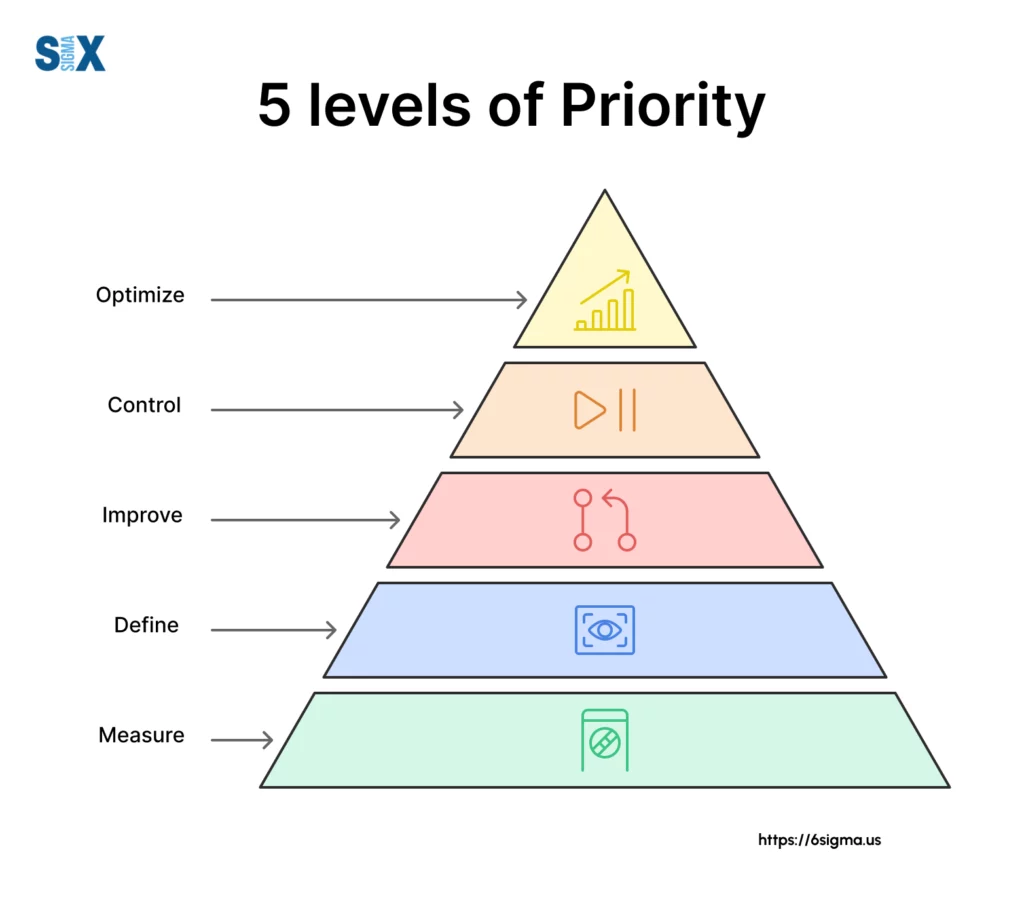
Six Sigma Connection
In Six Sigma, often explored in depth during a six sigma certification program, we use a similar concept called the Pareto Principle, or the 80/20 rule.
New to Six Sigma and want to build a foundation in prioritization? Our six sigma yellow belt certification introduces core concepts like the Pareto Principle, helping you prioritize tasks effectively from day one.
Practical Tips
- Regularly assess your task list and assign priority levels.
- Be honest about what truly qualifies as P1 or P2 – not everything can be a high priority.
- Use a digital tool or physical board to visualize your priorities.
- Review and adjust priorities weekly, or more frequently during high-pressure periods.
As we move forward, let’s explore how to implement these priority levels effectively in project management.
Implementing Priority Levels in Project Management
Now that we’ve established a solid understanding of priority levels, let’s dive into how these can be effectively implemented in project management.
As someone who’s guided numerous organizations through process improvement initiatives, often leveraging skills gained from a six sigma certification, I can attest that mastering priority levels is a game-changer in project success.
The Role of Priority Levels in Project Management
Priority levels are the backbone of efficient project management. They provide a structured approach to decision-making, ensuring that resources are allocated to the most critical tasks first.
In my experience working with companies like Dell and 3M, I’ve seen how well-implemented priority levels can dramatically improve project timelines and outcomes.
By clearly defining what’s urgent and important, priority levels help project managers:
- Focus team efforts on high-impact activities
- Manage stakeholder expectations more effectively
- Identify and mitigate risks early in the project lifecycle
- Optimize resource allocation for maximum efficiency
Step-by-Step Guide to Implementing Priority Levels
Implementing priority levels in your project management approach doesn’t have to be complicated. Here’s a step-by-step guide I’ve refined over years of practice:
- Assess Project Goals and Constraints: Begin by clearly defining your project objectives and identifying any constraints (time, budget, resources).
- List All Tasks: Create a comprehensive list of all project tasks and deliverables.
- Evaluate Urgency and Importance: For each task, consider its time sensitivity and its impact on project goals.
- Assign Priority Levels: Use the P1-P5 system we discussed earlier to categorize each task.
- Communicate Priorities: Convey the priority levels and their meanings to all team members and stakeholders.
- Schedule Tasks: Arrange your project timeline based on these priorities, ensuring high-priority tasks are addressed first.
- Regular Review: Consistently reassess priorities as the project progresses and circumstances change.
One challenge I often see is maintaining consistent priority assignments across a team. To address this, I recommend creating clear, documented criteria for each priority level and conducting regular priority alignment meetings.
Case Study: Successful Priority Level Implementation
Let me share an example from my work with a major technology company. This organization was struggling with project delays and resource conflicts across multiple initiatives.
We implemented a structured priority level system, integrating it with their existing project management software. The result? Within six months, they saw a 30% reduction in project delays and a 25% improvement in resource utilization.
The key takeaways from this case were:
- Consistent use of priority levels across all projects improved cross-team collaboration
- Regular priority reviews helped in the early identification and mitigation of potential delays
- Clear communication of priorities reduced conflicts and improved stakeholder satisfaction
Six Sigma Connection
In Six Sigma, we use the PICK (Possible, Implement, Challenge, Kill) chart, which aligns closely with priority levels. This chart helps teams visualize tasks based on their effort and impact, much like our priority levels consider urgency and importance.
Practical Tips
- Use visual aids like color-coding or symbols to make priority levels easily identifiable
- Integrate priority levels into your project management software for seamless tracking
- Train team members on how to assess and assign priorities to promote consistency
- Regularly audit priority assignments to ensure they align with project goals and timelines
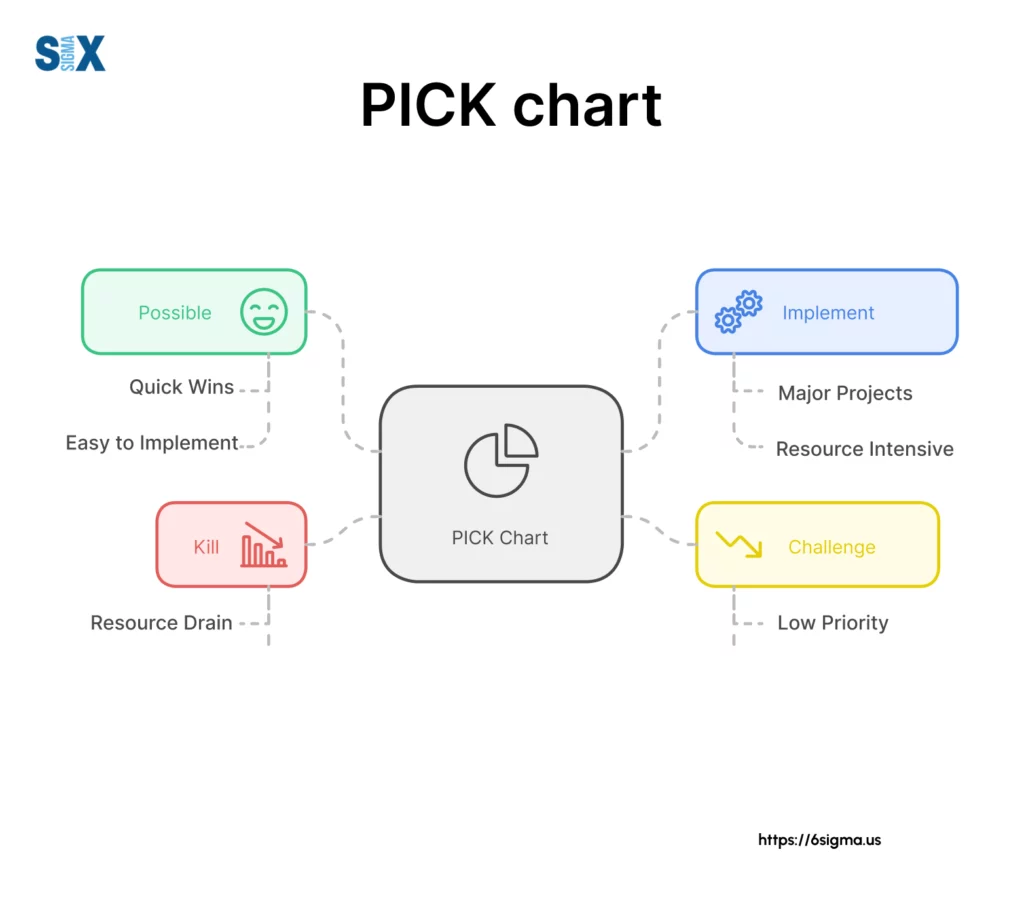
Take your prioritization skills to the next level with the Lean Six Sigma Black Belt program. Dive deep into advanced statistical tools and project management techniques to help you lead complex initiatives.
Now, let’s look at some advanced strategies for managing priorities in complex project environments.
Advanced Strategies for Managing Priorities
It’s crucial to explore advanced strategies that can help you navigate more complex scenarios.
In my years as a Six Sigma Master Black Belt, I’ve encountered numerous situations where basic prioritization techniques fall short. This section will equip you with the tools to handle these challenging situations effectively.
Handling Conflicting Priorities
One of the most common challenges in priority management is dealing with conflicting priorities. It’s not uncommon for multiple stakeholders to insist that their projects or tasks are the most critical. Here are some techniques I’ve found effective in resolving these conflicts:
- Objective Criteria: Establish a set of objective criteria for evaluating priorities. This could include factors like financial impact, strategic alignment, and resource requirements.
- Stakeholder Analysis: Conduct a thorough stakeholder analysis to understand the needs and influences of different parties involved.
- Negotiation and Compromise: Sometimes, finding a middle ground is necessary. This might involve breaking larger tasks into smaller, manageable chunks that can be prioritized separately.
- Escalation Process: Have a clear escalation process in place for when conflicts can’t be resolved at the team level.
In my work with GE, we implemented a priority scoring system that took into account multiple factors. This system significantly reduced conflicts and provided a transparent method for priority assignment.
Adapting Priority Levels to Different Industries
It’s important to recognize that priority levels may need to be adapted based on the specific needs of different industries. For example:
- In healthcare, patient safety might always be the top priority (P1), while administrative tasks might typically fall into lower priority levels.
- In software development, critical bugs affecting user experience might be P1, while new feature development might be P2 or P3.
- In manufacturing, maintaining production line efficiency might be a constant P1 priority.
The key is to tailor your priority system to align with your industry’s specific goals and challenges. When I worked with a major automotive manufacturer, we developed a custom priority matrix that incorporated both urgency and potential impact on production efficiency.
The Psychology of Prioritization
Understanding the psychological aspects of prioritization can greatly enhance your ability to manage priorities effectively. Some common cognitive biases that affect priority setting include:
- Recency Bias: Tendency to prioritize recent tasks over older ones, regardless of actual importance.
- Sunk Cost Fallacy: Continuing to prioritize a project because of past investment, even when it’s no longer the best use of resources.
- Planning Fallacy: Underestimating the time required for tasks, leading to unrealistic priority assignments.
To overcome these biases, consider techniques like:
- Regular priority reviews with a diverse team to challenge assumptions
- Using data-driven decision-making tools to support priority assignments
- Implementing a structured prioritization framework like the Eisenhower Matrix
Six Sigma Connection
In Six Sigma, we use a tool called Failure Mode and Effects Analysis (FMEA) to prioritize potential failures based on severity, occurrence, and detection.
Our root cause analysis training equips you with Six Sigma tools like FMEA to prioritize tasks objectively and resolve conflicts efficiently.
This methodology can be adapted to general priority management, helping teams objectively assess the criticality of different tasks or projects.
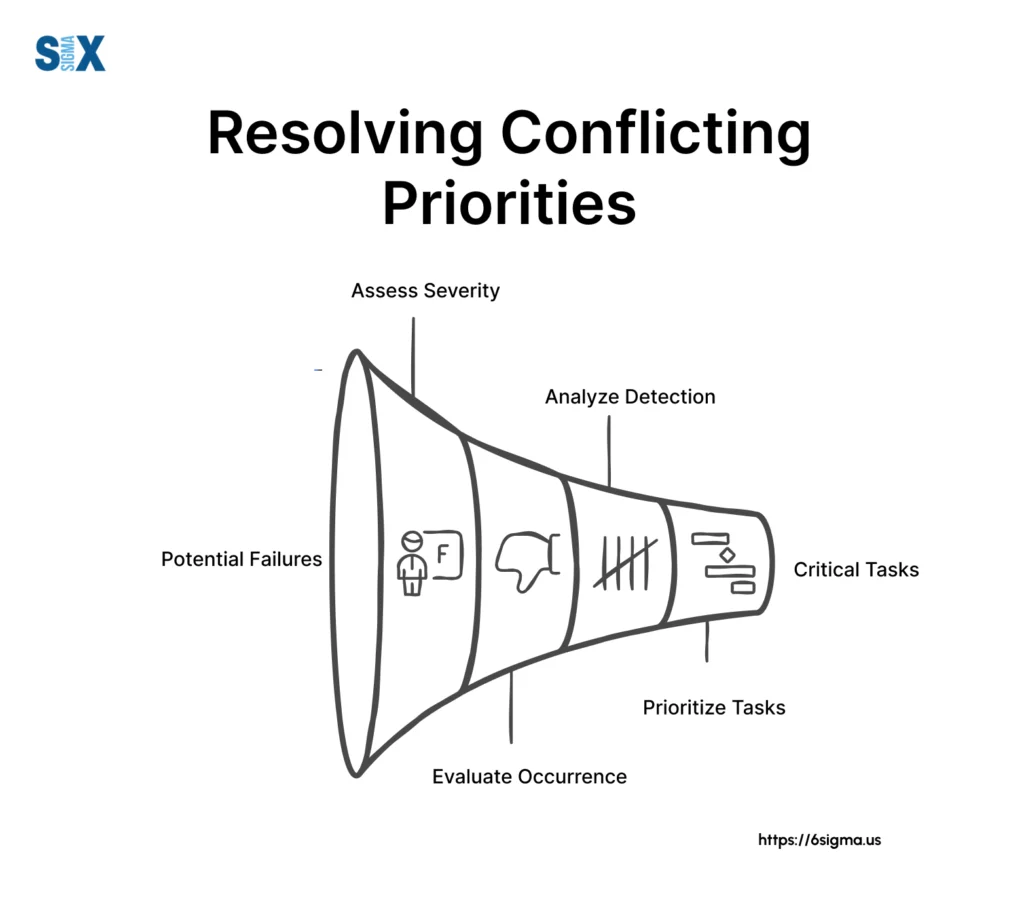
Practical Tips
- Develop a standardized priority scoring system for your organization
- Regularly train team members on priority management techniques
- Use visualization tools like Kanban boards to make priorities clear and visible
- Encourage open communication about priorities and potential conflicts
As we move forward, we’ll explore how to integrate these advanced prioritization strategies with project management tools and software, further enhancing your ability to manage complex priority scenarios.
Integrating Priority Levels with Project Management Tools
In today’s digital age, leveraging technology to manage priority levels is not just an option – it’s a necessity. As we move forward in our exploration of priority management, let’s examine how modern project management tools can enhance our ability to set, track, and adjust priorities effectively.
Popular Project Management Tools and Priority Features
Most popular project management software packages offer built-in features for managing priority levels. In my consultancy work, I’ve had the opportunity to work with various tools across different organizations. Here’s a quick overview of how some common tools handle priorities:
- Jira: Offers customizable priority fields, allowing teams to set their priority levels and even create custom fields for more nuanced prioritization.
- Trello: Uses labels and custom fields to denote priorities, with the ability to color-code for easy visual identification.
- Asana: Provides priority fields and the ability to sort and filter tasks based on priority levels.
- Microsoft Project: Offers multiple ways to set and visualize priorities, including priority fields and custom views.
When customizing priority settings in these tools, I always recommend:
- Aligning the tool’s priority levels with your organization’s defined levels (P1-P5, for instance)
- Using consistent color coding across all projects for easy recognition
- Setting up automated notifications for high-priority items
- Regularly reviewing and updating priority settings to ensure they remain relevant
Automating Priority Management
The advent of AI and machine learning has opened up exciting possibilities in priority management. These technologies can analyze vast amounts of project data to suggest priority levels based on factors like deadlines, resource availability, and historical performance.
For instance, when working with a large tech company, we implemented an AI-driven priority management system that could:
- Predict potential bottlenecks and suggest priority adjustments
- Analyze team capacity and automatically flag over-allocation of high-priority tasks
- Learn from past project performance to improve future priority assignments
While these automated systems offer significant benefits, it’s crucial to be aware of potential drawbacks:
Over-reliance on automation can lead to a lack of human judgment in critical decisions
- AI systems may not fully understand the context or nuanced business priorities
- There’s a risk of teams becoming overly dependent on technology, potentially losing their prioritization skills
Despite these challenges, when implemented thoughtfully, automation can significantly enhance priority management. The key is to use these tools as aids to human decision-making, not replacements for it.
Six Sigma Connection
In Six Sigma, we often use the DMAIC (Define, Measure, Analyze, Improve, Control) methodology for process improvement. This same approach can be applied to implementing and refining priority management systems within project management tools:
- Define: Establish your priority levels and criteria
- Measure: Use the tool’s reporting features to track priority-related metrics
- Analyze: Regularly review data to identify trends and areas for improvement
- Improve: Implement changes based on your analysis
- Control: Set up automated checks and balances to maintain the system’s effectiveness
Practical Tips
- Start with a pilot project when implementing new priority management features or tools
- Provide thorough training to ensure all team members understand how to use and interpret priority indicators
- Regularly solicit feedback from users to identify pain points and improvement opportunities
- Consider integrating your project management tool with other systems (like CRM or ERP) for a more holistic view of priorities across the organization
Measuring the Impact of Effective Prioritization
As we discussed the intricacies of priority levels and their implementation, let’s understand how to measure the impact of these efforts.
In my years as a Six Sigma Master Black Belt, I’ve learned that what gets measured gets managed. Let’s dive into how we can quantify the success of our prioritization strategies.
Key Performance Indicators for Priority Management
To truly gauge the effectiveness of your priority system, you need to track specific metrics. Here are some key performance indicators (KPIs) I’ve found particularly useful:
- On-Time Completion Rate: The percentage of tasks completed by their due date. This should increase as priority management improves.
- Resource Utilization: How efficiently your team’s time and skills are being used. Effective prioritization should optimize this metric.
- Project Cycle Time: The time it takes to complete a project from start to finish. Well-managed priorities often lead to shorter cycle times.
- Stakeholder Satisfaction: Measured through surveys, this indicator reflects how well priorities align with stakeholder expectations.
- Number of Priority Conflicts: The frequency of disagreements over task importance. This should decrease over time.
When tracking these metrics, it’s important to:
- Establish a baseline before implementing new priority systems
- Set realistic targets for improvement
- Regularly review and analyze the data
- Use visualization tools to make trends easily understandable
Do these concepts feel overwhelming? Our Six Sigma certification programs break them down into simpler steps, and you can consult one-on-one with Six Sigma experts to gain more knowledge and learn from their experience.
Case Studies: Before and After Implementing Priority Levels
Let me share a couple of brief case studies that illustrate the power of effective prioritization:
Case Study 1: Manufacturing Company
Before: A large manufacturing firm was struggling with frequent production delays and missed deadlines.
After: Implementing a structured priority system, they saw:
- 30% reduction in project delays
- 25% improvement in on-time delivery
- 15% increase in overall productivity
Case Study 2: Software Development Startup
Before: A young tech company was facing challenges in managing multiple product features and bug fixes.
After: Adopting a clear priority framework resulted in:
- 40% decrease in critical bugs reaching production
- 20% increase in new feature delivery rate
- 35% improvement in customer satisfaction scores
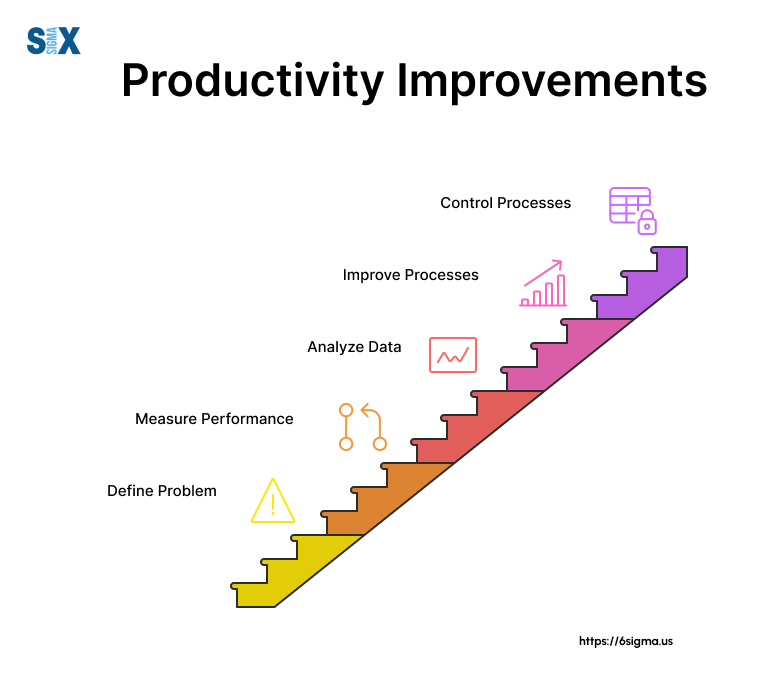
Looking to implement effective prioritization across your entire organization just like in the above case studies? Our Lean Six Sigma Champion Leadership program equips executives with the skills to drive organizational change and support data-driven decision-making.
Six Sigma Connection
In Six Sigma, we use a concept called “Critical to Quality” (CTQ) to identify the characteristics of a product or service that are most important to the customer.
Similarly, in priority management, we’re identifying the tasks and projects that are most critical to our business goals. By focusing on these high-priority items, we can significantly improve overall performance and customer satisfaction.
To understand key concepts like Critical to Quality, perfect for beginners check out our Six Sigma White Belt Certification.
Practical Tips
- Use a balanced scorecard approach to track both quantitative and qualitative metrics
- Regularly communicate priority-related KPIs to all team members to maintain focus
- Conduct periodic audits of your priority system to ensure it’s still aligned with business goals
- Use data visualization tools to make priority management metrics more accessible and actionable
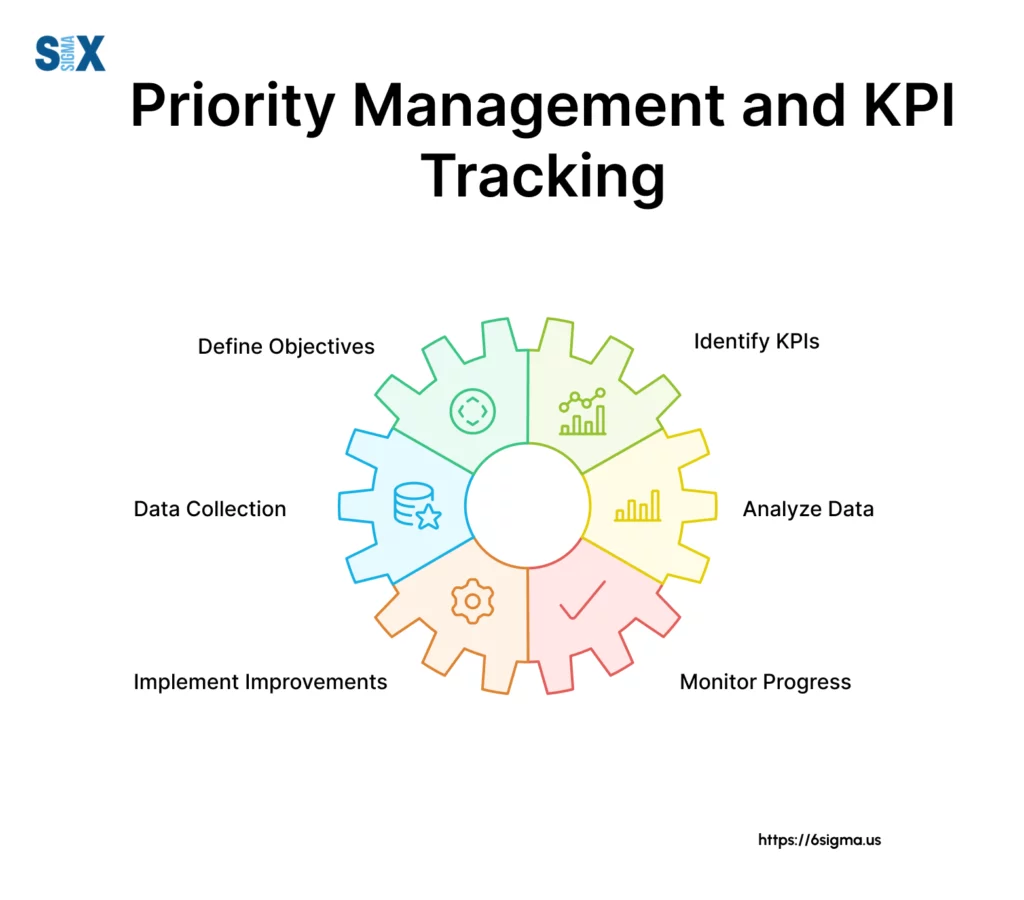
Overcoming Common Challenges in Priority Management
Let’s address the common hurdles that organizations face when implementing and maintaining effective priority management systems.
In my years of consulting with companies like HP, Dell, etc. I’ve encountered several recurring challenges. Let’s explore these issues and discuss strategies to overcome them.
Identifying and Addressing Priority Creep
Priority creep is a subtle yet pervasive problem that can undermine even the best-laid priority management plans. It occurs when tasks or projects gradually increase in perceived importance over time, regardless of their actual impact on organizational goals.
To combat priority creep:
- Regularly review and reassess priorities: Schedule weekly or bi-weekly priority review sessions.
- Use objective criteria: Implement a scoring system based on factors like strategic alignment, revenue impact, and resource requirements.
- Encourage pushback: Create a culture where team members feel comfortable questioning priority assignments.
In my work with a major telecommunications company, we implemented a monthly priority reset meeting. This simple practice reduced the number of “high priority” tasks by 40%, allowing the team to focus on truly critical work.
Balancing Urgent vs. Important Tasks
The tension between urgent and important tasks is a classic challenge in priority management. The Eisenhower Matrix, named after President Dwight D. Eisenhower, is an excellent tool for addressing this issue.
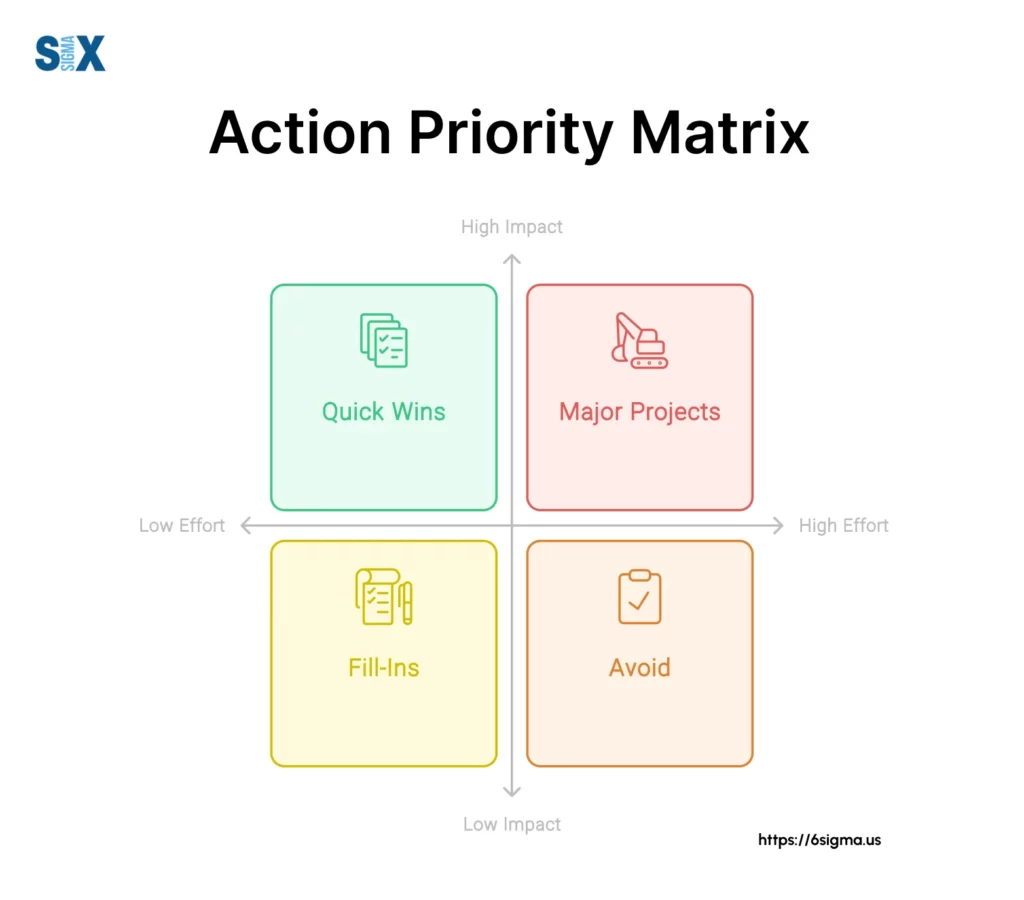
The matrix categorizes tasks into four quadrants:
- Urgent and Important: Do immediately
- Important but Not Urgent: Schedule for later
- Urgent but Not Important: Delegate if possible
- Neither Urgent nor Important: Eliminate
To effectively use this matrix:
- Regularly categorize tasks into these quadrants
- Focus on reducing time spent in the “Urgent but Not Important” quadrant
- Allocate dedicated time for “Important but Not Urgent” tasks to prevent them from becoming urgent
Cultivating a Priority-Focused Team Culture
Creating a culture that values effective prioritization is crucial for long-term success. Here are some strategies I’ve found effective:
- Lead by example: Leaders should openly discuss their prioritization processes.
- Provide training: Offer workshops on priority management techniques.
- Recognize good prioritization: Highlight team members who effectively manage priorities.
- Integrate priorities into performance reviews: Make effective priority management a key performance indicator.
I was once told by a leading organization’s CEO, “A team that understands and respects priorities is a team that delivers results consistently.”
Six Sigma Connection
In Six Sigma, we use a tool called the Control Chart to monitor processes and identify when they’re going out of control. Similarly, in priority management, regular monitoring and control mechanisms are essential to prevent priority creep and maintain focus on what’s truly important.
Practical Tips
- Implement a priority scoring system to objectively assess task importance
- Use visual management tools like Kanban boards to make priorities visible to all
- Conduct regular priority alignment meetings to ensure team-wide understanding
- Encourage time-blocking techniques to balance urgent and important tasks
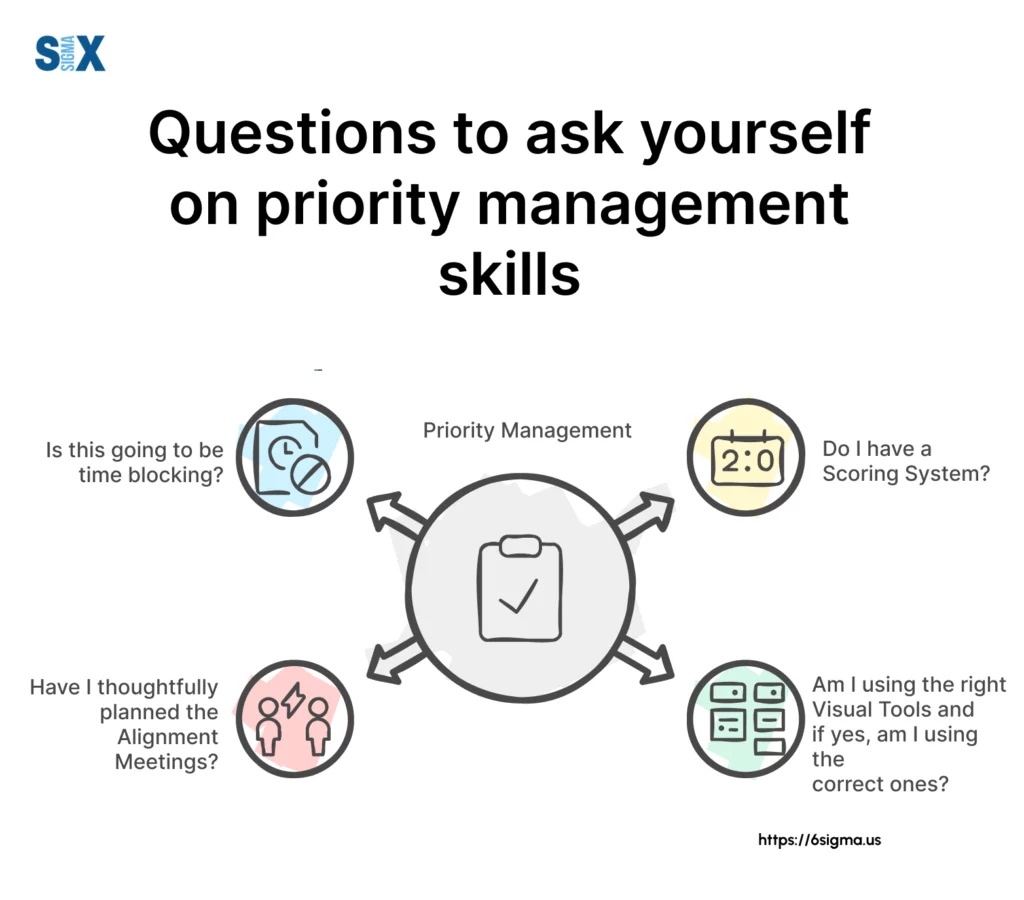
Conclusion: Mastering Levels of Priority for Project Success
It’s clear that mastering this skill is not just a nice-to-have, but a critical component of successful project management and business operations.
Let’s recap the key points we’ve covered:
- Priority levels provide a structured approach to task management, helping teams focus on what truly matters.
- Implementing priority levels in project management can significantly improve resource allocation, timeline management, and overall project success.
- Advanced strategies, such as handling conflicting priorities and adapting to different industries, are crucial for dealing with complex scenarios.
- Integrating priority management with project management tools and automation can enhance efficiency and decision-making.
- Measuring the impact of prioritization through key performance indicators is essential for continuous improvement.
- Overcoming challenges like priority creep and balancing urgent vs. important tasks is key to maintaining an effective priority system.
The value of effective priority management cannot be overstated. In my years as a Six Sigma Master Black Belt, I’ve seen firsthand how organizations that master this skill consistently outperform their peers.
They complete projects faster, allocate resources more efficiently, and adapt more quickly to changing business environments.
Now, it’s your turn to put these principles into action. I encourage you to start implementing a priority system in your work or organization today.
Remember, mastering priority levels is an ongoing journey. It requires consistent effort, regular reassessment, and a commitment to continuous improvement.
But with the strategies and tools we’ve discussed, you’re well-equipped to take on this challenge and drive your projects and organization toward greater success.
To more efficient, effective, and successful project management!
SixSigma.us offers both Live Virtual classes as well as Online Self-Paced training. Most option includes access to the same great Master Black Belt instructors that teach our World Class in-person sessions. Sign-up today!
Virtual Classroom Training Programs Self-Paced Online Training Programs






